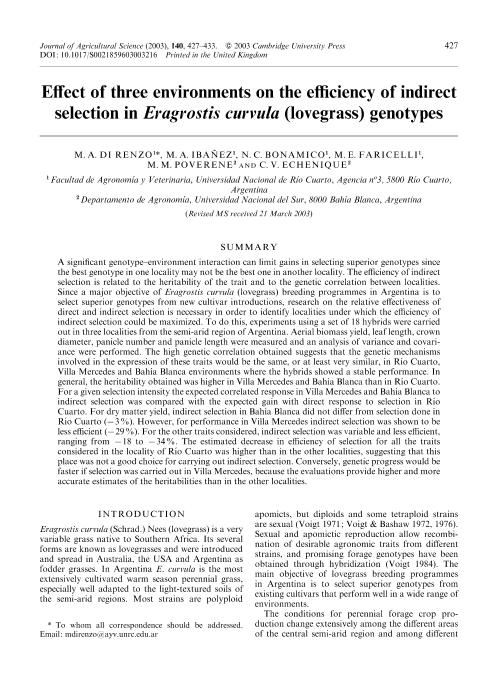Artículo
Effect of three environments on the efficiency of indirect selection in Eragrostis curvula (lovegrass) genotypes
Di Renzo, Miguel Angel; Ibañez, M. A.; Bonamico, Natalia Cecilia ; Faricelli, M. E.; Poverene, María Mónica
; Faricelli, M. E.; Poverene, María Mónica ; Echenique, Carmen Viviana
; Echenique, Carmen Viviana
 ; Faricelli, M. E.; Poverene, María Mónica
; Faricelli, M. E.; Poverene, María Mónica ; Echenique, Carmen Viviana
; Echenique, Carmen Viviana
Fecha de publicación:
06/2003
Editorial:
Cambridge University Press
Revista:
Journal Of Agricultural Science
ISSN:
0021-8596
Idioma:
Inglés
Tipo de recurso:
Artículo publicado
Clasificación temática:
Resumen
A significant genotype environment interaction can limit gains in selecting superior genotypes since the best genotype in one locality may not be the best one in another locality. The efficiency of indirect selection is related to the heritability of the trait and to the genetic correlation between localities.Since a major objective of Eragrostis curvula (lovegrass) breeding programmes in Argentina is to select superior genotypes from new cultivar introductions, research on the relative effectiveness of direct and indirect selection is necessary in order to identify localities under which the efficiency of indirect selection could be maximized.To do this, experiments using a set of 18 hybrids were carried out in three localities from the semi-arid region of Argentina. Aerial biomass yield, leaf length, crown diameter, panicle number and panicle length were measured and an analysis of variance and covariance were performed. The high genetic correlation obtained suggests that the genetic mechanisms involved in the expression of these traits would be the same, or at least very similar, in Rı´o Cuarto, Villa Mercedes and Bahı´a Blanca environments where the hybrids showed a stable performance. In general, the heritability obtained was higher in Villa Mercedes and BahÍa Blanca than in Rıo Cuarto. For a given selection intensity the expected correlated response in Villa Mercedes and BahÍa Blanca to indirect selection was compared with the expected gain with direct response to selection in Rıo Cuarto. For dry matter yield, indirect selection in Bahı´a Blanca did not differ from selection done inRı´o Cuarto (x3%). However, for performance in Villa Mercedes indirect selection was shown to be less efficient (x29%). For the other traits considered, indirect selection was variable and less efficient,ranging from x18 to x34%. The stimated decrease in efficiency of selection for all the traits considered in the Locality of RÍo Cuarto was higher than in the other localities, suggesting that this place was not a good choice for carrying out indirect selection. Conversely, genetic progress would be faster if selection was carried out in Villa Mercedes, because the evaluations provide higher and more accurate estimates of the heritabilities than in the other localities.
Palabras clave:
Indirect Selection
,
Lovegrass Genotypes
,
Efficiency
Archivos asociados
Licencia
Identificadores
Colecciones
Articulos(CERZOS)
Articulos de CENTRO REC.NAT.RENOVABLES DE ZONA SEMIARIDA(I)
Articulos de CENTRO REC.NAT.RENOVABLES DE ZONA SEMIARIDA(I)
Citación
Di Renzo, Miguel Angel; Ibañez, M. A.; Bonamico, Natalia Cecilia; Faricelli, M. E.; Poverene, María Mónica; et al.; Effect of three environments on the efficiency of indirect selection in Eragrostis curvula (lovegrass) genotypes; Cambridge University Press; Journal Of Agricultural Science; 140; 4; 6-2003; 427-433
Compartir
Altmétricas



